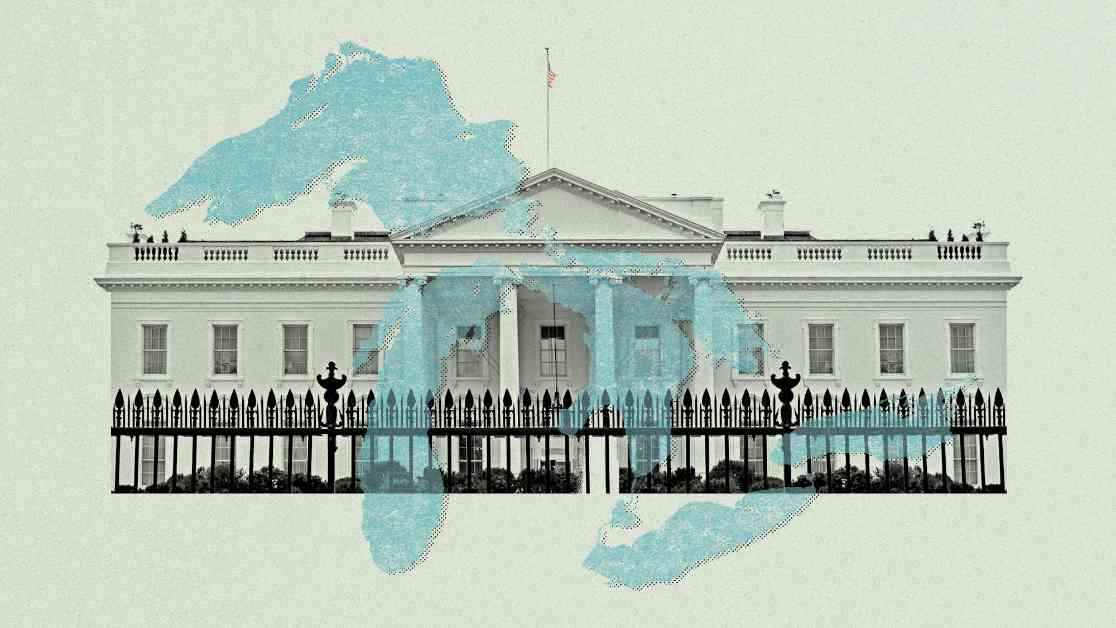J.D. Vance: A Beacon for Great Lakes Conservation or Trump Ally?
Over the past year, Vice President J.D. Vance, previously an Ohio senator, has played a crucial role in advocating for the Great Lakes Restoration Initiative (GLRI), one of the country’s largest commitments to preserving and revitalizing the Great Lakes. Tasked with fighting invasive species, algal blooms, pollution, and other ecosystem threats, Vance, as the co-chair of the Senate Great Lakes Task Force, championed the reauthorization bill that sought to extend and increase funding for the project until 2031.
In a bid to secure bipartisan support, Vance described the GLRI as a “commonsense” endeavor, urging his colleagues to back the initiative wholeheartedly. The GLRI, boasting a hefty budget, has been instrumental in funding a myriad of projects, ranging from microplastics research to algal bloom eradication to fortifying climate-resilient coastlines. Notably, the GLRI supports the preservation of the Great Lakes, which serve as the largest freshwater ecosystem globally and a primary drinking water source for about 10% of the U.S. population.
A bipartisan effort spearheaded by Democratic Senator Gary Peters of Michigan and Republican Senator Todd Young of Indiana seeks to prolong funding for the GLRI at $500 million annually over the next five years. The initiative is often lauded as a testament to political cohesion on conservation and environmental issues, bridging the ideological chasm that often characterizes policy debates.
However, despite bipartisan support, the GLRI faces an uncertain future, particularly under the looming shadow of the Trump administration. The Trump era witnessed repeated attempts to slash or eliminate GLRI funding, casting a pall of uncertainty over the program’s continuity. Given Vance’s evolving stance on environmental issues as he ascended the political hierarchy, concerns have been raised about his commitment to safeguarding the GLRI in the face of a changing political landscape.
The potential threat to the GLRI’s funding comes at a critical juncture when environmental spending is under scrutiny. The recent freezing of funds from key initiatives under President Joe Biden, coupled with a broader assault on environmental programs, has raised fears about the GLRI’s sustainability. Notably, Illinois Governor JB Pritzker’s preemptive move to halt construction on a billion-dollar project aimed at curbing invasive fish in the Great Lakes underscores the prevailing uncertainty surrounding the initiative’s future.
Laura Rubin, the director of Healing Our Waters–Great Lakes Coalition, underscores the pivotal role that Vance could play in preserving the GLRI, noting his past advocacy for the initiative. Rubin remains hopeful that Vance’s commitment to Great Lakes restoration will translate into tangible actions as the vice president. Despite the pressing need for political support for the GLRI, Vance’s office has refrained from commenting on the matter, leaving advocates and stakeholders in limbo regarding the future of the initiative.
Genesis of the GLRI: A Bipartisan Beacon for Environmental Preservation
The roots of the Great Lakes Restoration Initiative can be traced back to the early 2000s, a time marked by escalating environmental crises, including industrial and agricultural pollution, dwindling fish populations, and the encroaching threat of invasive species. Launched 15 years ago during the Obama administration, the GLRI was the brainchild of retired Michigan Senator Debbie Stabenow, who underscored the urgent need for a comprehensive fund capable of responding swiftly to environmental crises.
The GLRI’s inception was preceded by a 2004 executive order from former President George W. Bush, aimed at fostering enhanced coordination among federal agencies, states, and tribes to mitigate freshwater ecosystem degradation. Over the past 14 years, the GLRI has funded over 8,000 projects, with the federal government funneling approximately $5 billion into environmental preservation efforts, according to the U.S. Environmental Protection Agency.
According to Rubin, the GLRI’s funding has been instrumental in a wide array of initiatives, ranging from remediating contaminated sites in harbors and cities to habitat restoration, invasive species eradication, and public outreach and education. The economic benefits of the GLRI are also noteworthy, with a 2018 economic analysis highlighting that every federal dollar invested in the initiative yields about $3 in additional benefits, underscoring the program’s economic viability.
Republican Representative Bill Huizenga, a stalwart supporter of the GLRI, has spearheaded the latest push to extend funding for the initiative. Huizenga’s advocacy for the GLRI highlights the program’s dual ecological and economic significance, emphasizing the imperative of conveying the importance of the initiative to stakeholders and policymakers. Despite the economic and environmental merits of the GLRI, some challenges loom large on the horizon, particularly concerning the program’s funding allocation and operational efficiency.
Challenges on the Horizon: The Future of GLRI Amidst Political Uncertainty
As the GLRI navigates a tumultuous political landscape marked by shifting administrations and policy priorities, its sustainability and efficacy face mounting challenges. The Trump administration’s aggressive campaign to dismantle federal agencies, including the EPA, which oversees the GLRI, poses a significant threat to the initiative’s continuity.
Notably, the EPA’s workforce has been subjected to significant cuts and restructuring, raising concerns about the agency’s capacity to oversee the GLRI effectively. The looming specter of diminished staffing levels and budgetary constraints within the EPA could undermine the GLRI’s implementation and jeopardize its long-term success.
Nicole Cantello, president of the union representing regional EPA workers, voiced apprehension over the Trump administration’s actions, warning that the EPA’s Great Lakes National Program Office, a key player in GLRI implementation, could face substantial challenges in the wake of staffing reductions. The program’s vulnerability to budget cuts, exemplified by the slow allocation of funds from the bipartisan infrastructure law, underscores the urgent need for sustained political support and financial resources to bolster the GLRI’s efficacy.
Don Jodery, director of federal relations for the nonprofit Alliance of the Great Lakes, emphasized the critical importance of preserving essential environmental programs like the GLRI, noting that their funding should be non-negotiable. The imperative of safeguarding the GLRI’s funding and operational capacity is paramount to ensuring the continued protection and restoration of the Great Lakes region, underscoring the need for concerted political action and advocacy to secure the initiative’s future.














